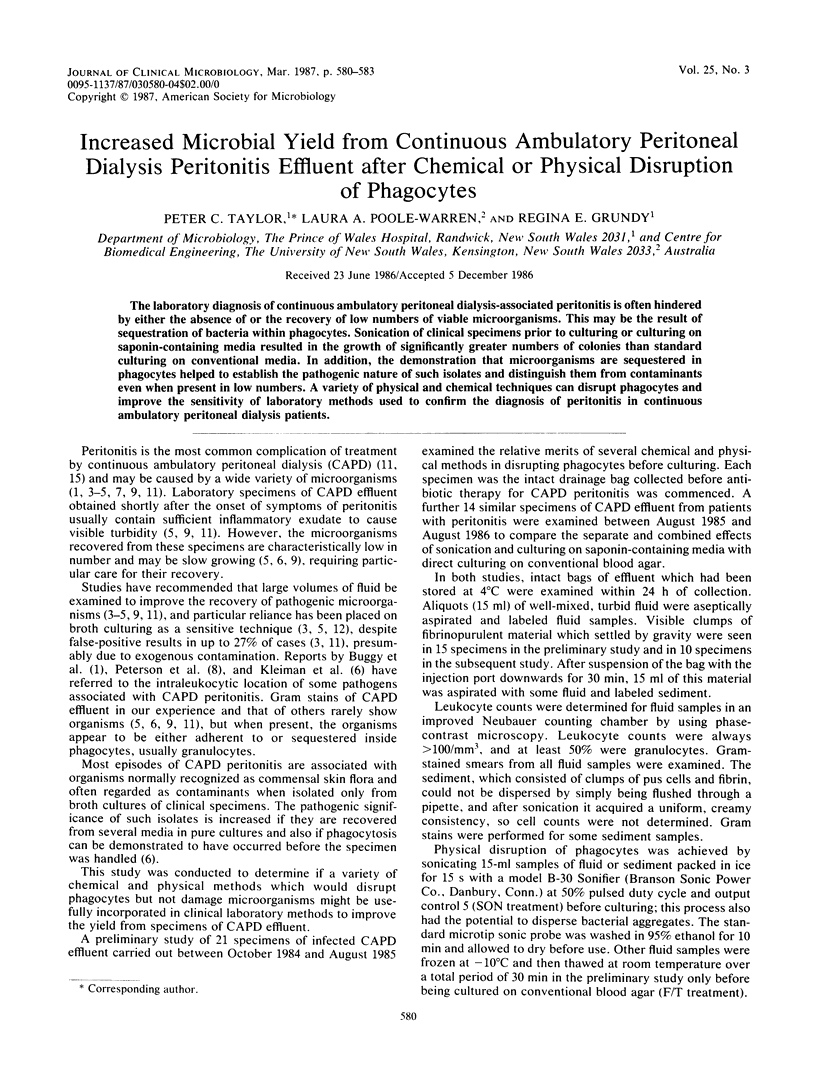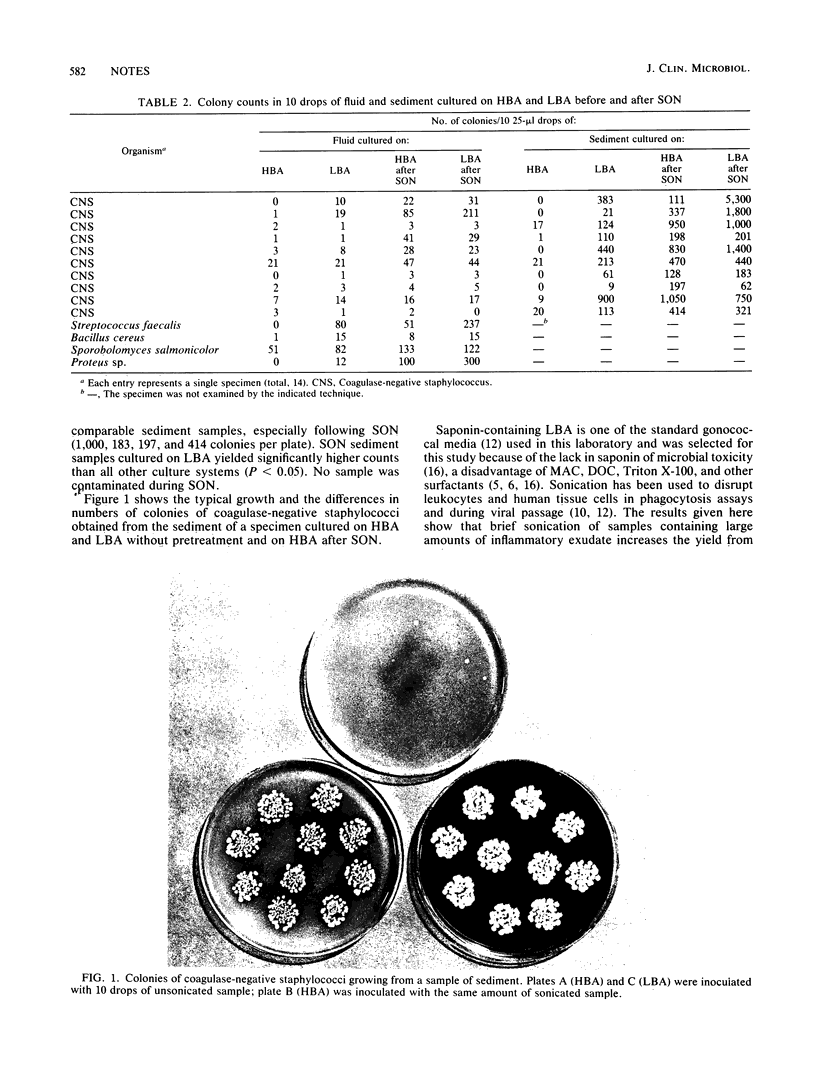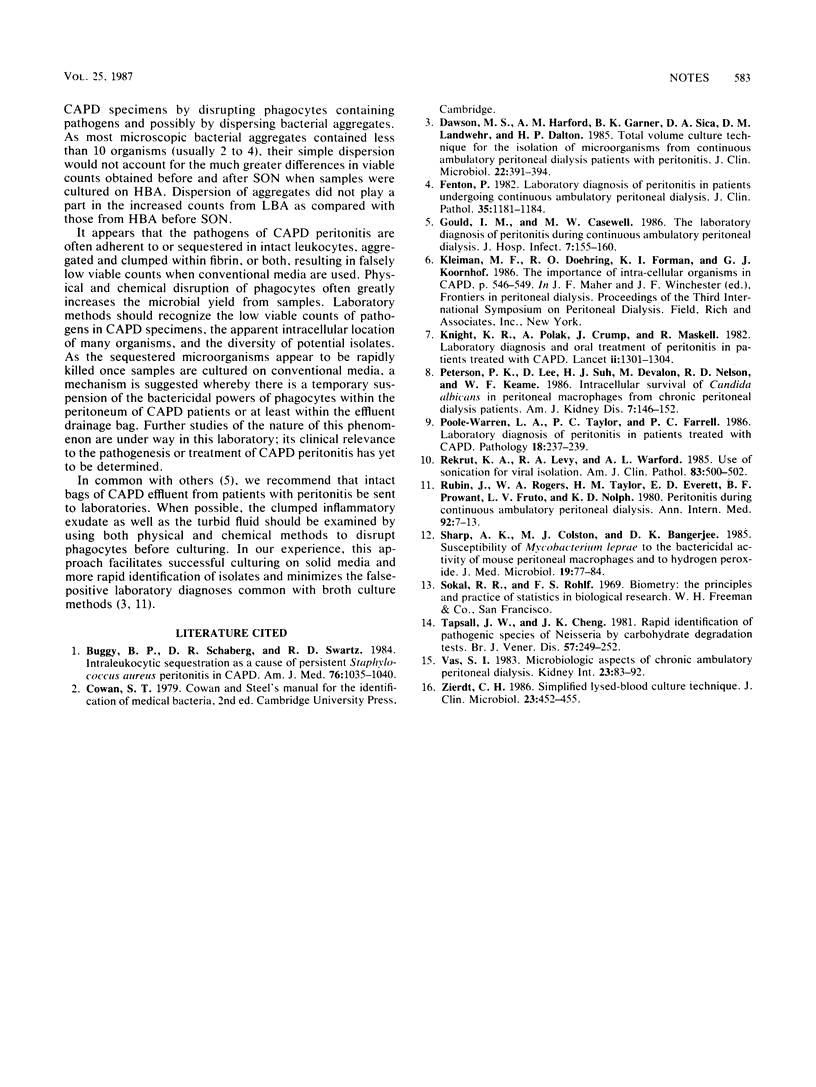Abstract
The laboratory diagnosis of continuous ambulatory peritoneal dialysis-associated peritonitis is often hindered by either the absence of or the recovery of low numbers of viable microorganisms. This may be the result of sequestration of bacteria within phagocytes. Sonication of clinical specimens prior to culturing or culturing on saponin-containing media resulted in the growth of significantly greater numbers of colonies than standard culturing on conventional media. In addition, the demonstration that microorganisms are sequestered in phagocytes helped to establish the pathogenic nature of such isolates and distinguish them from contaminants even when present in low numbers. A variety of physical and chemical techniques can disrupt phagocytes and improve the sensitivity of laboratory methods used to confirm the diagnosis of peritonitis in continuous ambulatory peritoneal dialysis patients.
Full text
PDF



Images in this article
Selected References
These references are in PubMed. This may not be the complete list of references from this article.
- Buggy B. P., Schaberg D. R., Swartz R. D. Intraleukocytic sequestration as a cause of persistent Staphylococcus aureus peritonitis in continuous ambulatory peritoneal dialysis. Am J Med. 1984 Jun;76(6):1035–1040. doi: 10.1016/0002-9343(84)90854-4. [DOI] [PubMed] [Google Scholar]
- Dawson M. S., Harford A. M., Garner B. K., Sica D. A., Landwehr D. M., Dalton H. P. Total volume culture technique for the isolation of microorganisms from continuous ambulatory peritoneal dialysis patients with peritonitis. J Clin Microbiol. 1985 Sep;22(3):391–394. doi: 10.1128/jcm.22.3.391-394.1985. [DOI] [PMC free article] [PubMed] [Google Scholar]
- Fenton P. Laboratory diagnosis of peritonitis in patients undergoing continuous ambulatory peritoneal dialysis. J Clin Pathol. 1982 Nov;35(11):1181–1184. doi: 10.1136/jcp.35.11.1181. [DOI] [PMC free article] [PubMed] [Google Scholar]
- Gould I. M., Casewell M. W. The laboratory diagnosis of peritonitis during continuous ambulatory peritoneal dialysis. J Hosp Infect. 1986 Mar;7(2):155–160. doi: 10.1016/0195-6701(86)90058-7. [DOI] [PubMed] [Google Scholar]
- Knight K. R., Polak A., Crump J., Maskell R. Laboratory diagnosis and oral treatment of CAPD peritonitis. Lancet. 1982 Dec 11;2(8311):1301–1304. doi: 10.1016/s0140-6736(82)91509-4. [DOI] [PubMed] [Google Scholar]
- Peterson P. K., Lee D., Suh H. J., Devalon M., Nelson R. D., Keane W. F. Intracellular survival of Candida albicans in peritoneal macrophages from chronic peritoneal dialysis patients. Am J Kidney Dis. 1986 Feb;7(2):146–152. doi: 10.1016/s0272-6386(86)80136-6. [DOI] [PubMed] [Google Scholar]
- Poole-Warren L. A., Taylor P. C., Farrell P. C. Laboratory diagnosis of peritonitis in patients treated with continuous ambulatory peritoneal dialysis. Pathology. 1986 Apr;18(2):237–239. doi: 10.3109/00313028609059466. [DOI] [PubMed] [Google Scholar]
- Rekrut K. A., Levy R. A., Warford A. L. Use of sonication for viral isolation. Am J Clin Pathol. 1985 Apr;83(4):500–502. doi: 10.1093/ajcp/83.4.500. [DOI] [PubMed] [Google Scholar]
- Rubin J., Rogers W. A., Taylor H. M., Everett E. D., Prowant B. F., Fruto L. V., Nolph K. D. Peritonitis during continuous ambulatory peritoneal dialysis. Ann Intern Med. 1980 Jan;92(1):7–13. doi: 10.7326/0003-4819-92-1-7. [DOI] [PubMed] [Google Scholar]
- Sharp A. K., Colston M. J., Banerjee D. K. Susceptibility of Mycobacterium leprae to the bactericidal activity of mouse peritoneal macrophages and to hydrogen peroxide. J Med Microbiol. 1985 Feb;19(1):77–84. doi: 10.1099/00222615-19-1-77. [DOI] [PubMed] [Google Scholar]
- Tapsall J. W., Cheng J. K. Rapid identification of pathogenic species of Neisseria by carbohydrate degradation tests. Importance of glucose in media used for preparation of inocula. Br J Vener Dis. 1981 Aug;57(4):249–252. doi: 10.1136/sti.57.4.249. [DOI] [PMC free article] [PubMed] [Google Scholar]
- Vas S. I. Microbiologic aspects of chronic ambulatory peritoneal dialysis. Kidney Int. 1983 Jan;23(1):83–92. doi: 10.1038/ki.1983.15. [DOI] [PubMed] [Google Scholar]
- Zierdt C. H. Simplified lysed-blood culture technique. J Clin Microbiol. 1986 Mar;23(3):452–455. doi: 10.1128/jcm.23.3.452-455.1986. [DOI] [PMC free article] [PubMed] [Google Scholar]



